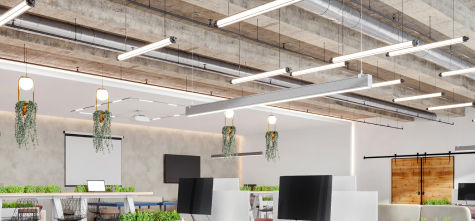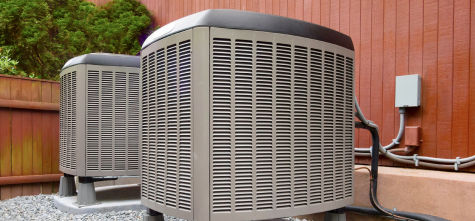Easy Efficiency Savings Tips
There are always more ways to save.
Looking for energy-saving, cost-cutting ways to keep your business running efficiently? Discover tips and strategies that can boost your bottom line and increase your return on investment. Whether you’re a smaller or large-scale business, you’ll find efficient solutions and money-saving rebates and instant discounts on equipment, lighting and more.

Use ENERGY STAR®-certified products. Compared to standard fixtures, ENERGY STAR®-certified fixtures typically use one-quarter of the energy and distribute light more efficiently. Lighting controls and sensors can reduce your energy use even more.
Take advantage of natural daylight. When investing in lighting for your business, determine areas where natural light can substitute for light fixtures during peak office hours. Besides reducing energy use and saving you money, natural daylight has been shown to increase employee wellness and productivity.
Switch to LED bulbs. Swapping out incandescent bulbs for ENERGY STAR®-certified light-emitting diode (LED) bulbs uses less energy and generates considerably less heat, reducing your cooling needs.
Install dimmers on LED bulbs. Daylight sensors automatically dim room lights based on the available natural sunlight.
Use occupancy sensors. Install sensors that automatically turn lights on and off in frequently unoccupied areas like restrooms or supply rooms. Occupancy sensors reduce your energy usage and cut down on maintenance costs. Turning fluorescent lights off for 12 hours each day can extend their life by 75%.
Add timers and motion sensors. Why keep restrooms, conference rooms and long hallways constantly lit when they aren’t occupied? Many ENERGY STAR®-certified LEDs are now compatible with motion and touch sensors and automatic timers.
Close off unoccupied areas. Do you have office spaces that aren’t frequently occupied? Turn off or reduce the cooling or heating systems in areas not often used, such as storage and non-public spaces. Reducing the airflow in these areas will maximize comfort, efficiency and productivity where it matters.
Install programmable thermostats. Programmable thermostats let you control your building’s temperature where and when you need it. These devices are ideal for managing the office’s climate during off-peak hours and in areas with less daily traffic. Adjusting the temperature settings in your facility, even for just 8 hours each day, could save you up to 10% on your heating and cooling bills. If your facility doesn’t have a building automation system (BAS), consider cloud thermostats. They offer useful features like password protection, humidity control and utility peak load management capabilities.
Change HVAC filters regularly. Frequently checking your system’s filters may seem like a given, but it’s easy to forget when business gets hectic. Make it a company initiative to inspect all filters monthly, especially during heavy-use seasons like winter and summer. If a filter looks dirty, change it. At a minimum, you should change filters every three months. Dirty filters reduce airflow, which forces the system to use more energy to maintain the building’s climate.
Keep air ducts sealed, insulated and clean. Did you know that properly sealing and insulating your facility’s ductwork could improve your HVAC system’s efficiency by 20% or more? And keep them free of dust and dirt to ensure maximum airflow.
Use window shades and blinds for energy efficiency. In warmer weather, lower window shades to block direct sunlight and reduce cooling needs. During colder periods, open the blinds on south-facing windows to allow sunlight to heat the space.
Electronics and Automation
From computers to teleconferencing systems to office equipment, keeping your business running takes a lot of power. Computers contribute to around 20% of the overall electric consumption in offices. Put them in “sleep mode” during idle periods and turn them off during off-hours and weekends.
Use equipment power management features. Putting your computers and laptops in “sleep mode” during inactive periods can conserve unnecessary energy use. Look for commercial software power management packages that do this automatically.
Incorporate sustainable, energy-saving behaviors into the workplace. Many companies now integrate green teams, training programs, interactive energy-use kiosks and energy efficiency competitions to encourage employees to change behaviors. These changes could yield savings of up to 10% on your energy bill.
Make smart use of office equipment and appliances. From printers and fax machines to coffee makers and ovens, the equipment in your office draws a lot of power. Put idle machines in standby mode or on timers to reduce costs when they’re not being used. And add power strips with built-in occupancy sensors to power down small appliances like desk lamps, radios and small printers.
Upgrade to ENERGY STAR®-certified equipment. When it’s time to replace outdated equipment and appliances, switch to ENERGY STAR®-certified products for better efficiency, longer life and energy and cost savings.
Check door seals on refrigeration units. Tight seals and properly closed doors keep cold in and warm air out. Periodically check for leaks and watch for warning signs like frost buildup to cut down on cooling costs. Here’s a quick tip: Try sliding a dollar bill into the seal. If it slides in, it’s time to adjust your seals.
Reduce energy consumption with an induction cooktop. Induction cooktops reduce energy by 10% to 20% over conventional gas or electric cooktops. 85% to 90% of the energy gets transferred directly into the cooking pan. Less ambient heat is produced, which is safer and reduces cooling bills. These units also heat food faster, provide more stable temperatures and are easier to clean.
Clean refrigeration cooling coils. Dirt and ice buildup prevent proper heat transfer and lower a cooling unit’s efficiency and capacity. Clean the coils regularly to keep things running smoothly.
Give refrigeration units breathing room. Maintain an air gap of at least three inches between the wall and the back of refrigerators, water coolers and freezers.
Cut down on equipment downtime. Implement a startup/shutdown plan to ensure you only use equipment when needed.
Cool it when opening and closing refrigeration doors. Avoid opening and closing cooling unit doors constantly. Repeated temperature fluctuations will raise energy costs and may lower food quality.
Step up maintenance on walk-in refrigeration units. Adding easy-to-install strip curtains and automatic door closures can reduce outside air infiltration by about 75%.
Optimize your kitchen’s layout. Place all cooling equipment together when possible and do the same for heating equipment. Keep these groupings separate to prevent heat from warming your cooling equipment. And put refrigeration units in well-ventilated areas to allow them to expel heat efficiently.
Invest in an energy-efficient ice machine. ENERGY STAR®-certified ice makers provide energy savings of 10% and water savings of up to 25%. Choose a size capacity that’s best for your business. Larger ice machines can increase energy consumption. However, they typically consume less energy per unit of ice than smaller units.


